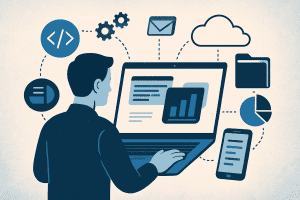May 2, 2025
While the AI hype cycle often centers on model releases, Anthropic’s latest launch takes a different—and more strategic—route. With the introduction of Claude Integrations and Advanced Research, Anthropic isn’t just chasing ChatGPT or Gemini. It’s redefining what it means for an AI agent to actually work for you.
Forget flashy conversations or philosophical debates with bots. Claude’s new capabilities are about AI doing real work, in real workflows, with real context.
It feels like we’re setting up for a VHS-BetaMax moment…
🔌 Integrations: Where Context Meets Control
Per this TechCrunch article, Claude’s new Integrations feature taps into Anthropic’s MCP (Model-Context Protocol), allowing developers to build connectors between Claude and their apps, tools, and content ecosystems. The result? A bot that doesn’t just respond—it understands your internal knowledge, project history, and tool usage.
Picture this:
- Claude pulling from Confluence pages to prep your client presentation.
- Automatically updating Jira tickets.
- Triggering Zapier workflows to log calls, send notifications, or spin up support cases.
Now fill-in the blank with any system you need to “ask questions” of…your LOS, POS, CRM, email,…that’s where this is headed. And whoever makes it the easiest and least expensive for you is likely to “win”.
It’s not just plug-and-play automation—it’s context-aware execution, and that’s a big leap. This is all a direct response to Google’s integration of everything-Google into Gemini so that users of its AI don’t have to struggle to apply AI to Google Drive files, Word, etc.
As the sidebar below illustrates, part of this is a battle in the trenches as each AI platform stakes-out its turf on “how” AI should talk to other stuff and, eventually, to other AIs. And, at least for now, OpenAI seems to be seriously lagging.
📦 Sidebar 1: AI Agent Interface Protocols – What Are MCP, ANA, and App Functions?
AI agents don’t work magic—they rely on specific protocols to connect with apps, data, and services. Here’s how the big three are doing it:
| Protocol | Used By | Purpose |
|---|---|---|
| MCP (Model-Context Protocol) | Anthropic / Claude | Enables Claude to access context-rich data from enterprise tools and take actions within them. Powers Claude Integrations. |
| ANA (Actionable Notification Agent) | OpenAI / ChatGPT | Connects ChatGPT to APIs, enabling it to trigger workflows, retrieve data, and act like a co-pilot. Powers ChatGPT Actions. |
| App Extensions / AI Agents API | Google / Gemini | Allows Gemini to access and act within Google Workspace (Gmail, Drive, Calendar) and partner apps. Includes Google App Extensions for user workflows. |
Each protocol reflects a different strategy, but all aim to turn conversational AI into functional AI—connected, capable, and context-aware.
🛡️ Sidebar 2: What AI Agent Interface Protocols Actually Handle
Agent protocols like MCP, ANA, and Function Calling don’t just define what the AI can connect to—they manage the infrastructure that makes those connections secure and trustworthy. Here’s what they typically handle:
| Layer | What It Does |
|---|---|
| Authentication | Ensures the AI agent has secure credentials (OAuth, API keys, etc.) to access tools. |
| Authorization | Controls what data and actions the AI can perform based on user roles and scopes. |
| Rate Limiting & Throttling | Prevents abuse, ensures agent activity doesn’t overwhelm APIs or services. |
| Schema Validation | Checks that inputs/outputs to/from tools are valid—avoiding malformed or unsafe actions. |
| Audit & Logging | Tracks what the agent accessed, when, and why—critical for governance and compliance. |
| User Context Injection | Injects user-relevant metadata (project, department, past interactions) to shape output. |
Together, these layers transform an AI model into a secure, enterprise-ready agent capable of meaningful, auditable work. You may not need to care about these details, but for AI to succeed, these standards will need to be in-place and widely adopted.
🔍 Advanced Research: Slower, Smarter, and More Transparent
The second part of Anthropic’s announcement surrounded Advanced Research. Claude is pivoting away from quick-but-shallow output to structured, multi-layered investigation. This feature lets users toggle a “Research mode” that breaks down a topic, investigates it across “hundreds” of internal and external sources, and returns a fully cited report within 5–45 minutes.
In other words: Claude becomes your analyst—one that cross-references, triangulates, and (allegedly) checks its own facts.
What sets this apart isn’t just source depth—it’s traceability. The report includes linked citations back to original material, offering a far more audit-friendly and trustable outcome than the standard AI hallucination-fest.
It’s fascinating that there are things that require such a long time to research. Not sure these really address the use cases you are likely to experience because if you need this level of research, the costs are going to add up quickly. And that is not typically a characteristic of valuable mortgage technology…
💼 The Implication for CIOs and Enterprise Leaders
Anthropic’s direction is clear: AI is no longer just an interface—it’s an operating layer. And the vendors who win will be those who:
- Embed themselves into enterprise ecosystems, not just chat windows.
- Offer transparency and explainability alongside capability.
- Create a bridge between unstructured requests and structured execution.
With partners like Atlassian, Zapier, and PayPal already in the mix, Claude is showing how AI tools can become deeply embedded in business systems—not just bolted on.
🧠 The Bigger Picture: AI Isn’t Getting Flashier—It’s Getting Functional
There’s a broader shift here. While OpenAI and Gemini push multi-modal boundaries, Claude is quietly becoming a trusted teammate for knowledge work. This isn’t about chat. It’s about actionable AI—and the infrastructure to back it up.
Enterprise buyers should be watching this closely. Because in the coming wave of AI adoption, the question won’t be which model is smartest—it’ll be which one knows your business best.


